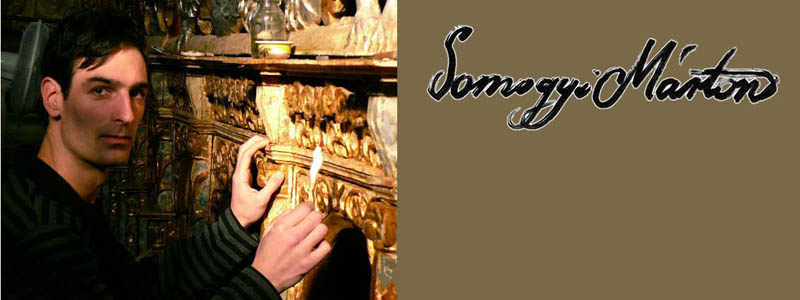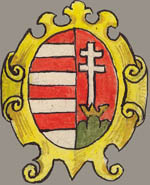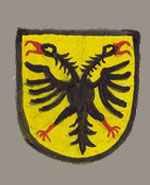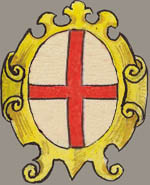
go to main page
telefon: 06 30 3171924
studio: 1087 Budapest, Kerepesi út 1. 1/8

PAINTER-ARTIST,
RESTORER
go to main page telefon: 06 30 3171924 studio: 1087 Budapest, Kerepesi út 1. 1/8 |
| nyelv: |  |
sprache |  |
language |  |
Charta Bellica rules
 |
| Card values in ascending order: Numbered cards I-X, Priest, Queen Sovereign, Monarch, Capital. So priests are worth 11, queen sovereigns 12, monarchs 13 and capitals 14 battle card values. |
|
Charta Bellica Preparations: For this line of play 4 players are needed.
Set
the 14 cards of the 4 nations each apart. Turn the four aces (capitals)
upside
down to decide by lot for the nations. One of the players takes his/her
own
capital while choosing an ally from the other 3 cards. The remaining
two make
up the enemy. All the four players shuffle their 14 cards and put seven
of them
upside down on the table, without having a look. The other seven are
held in
the hand. Simple line of
play: The player
(let us say Hungarian) having chosen an ally (let us say Polish) from
the 3
other nations leads an attack by showing the uppermost one of his/her 7
cards
on the table. The enemy opposite (let us say Austrian) shows the
uppermost one
of his/her cards at the same time. Now they can see how strong their
armies are
and the allies are called to aid (Hungarian-Polish contra
Austrian-Turkish
alliance in the example). Both of the allies table one (as a relief
force) of the
7 cards in their hands next to the one of their own ally to go beyond
the total
of that of the enemies’
two
cards. Then all the 4
cards are taken by the alliance with the total (battle card value)
higher. When battle card values equal, both
allies withdraw their relief forces and draw cards from each other to
decide
their final relief force. Next time the other two allies (i.e. the
Polish and
the Turk) show the uppermost one of their cards on the table and are
sent
relief forces (by the Hungarian and the Austrian, respectively). The
game comes
to an end when all the players run out of cards. Then both alliances
count the
value total of their cards collected. The simplest way of doing this is
to put
out the cards of the same value on both sides and add no more than the
value of
the remaining cards. The winner is the alliance with the total card
value
higher. Combined line of
play: It means that
certain pairs of cards have extra battle card values. Total amount 13 overtrumps any number
card sum, a pair overtrumps total amount 13, an élite partner
overtrumps any
pair, an élite pair overtrumps any élite partner, and
jester partner overtrumps
any élite pair. But any jester partner is overtrumped by a
greater number, by
total value 13, by a pair and by such elite partners which are not
partners of
the jester. Bellum (Lat. War) Preparations: For this line of play two, three or four
players
are needed. All the players have the cards of one nation, i.e. they
have cards
of the same value total. The point is to take the stronger cards of the
other(s). Line of Play: Players take one card and hand it forward
back
side up, then turn it over at once. The card of the highest value
overtrumps
all the other ones. Players with cards of the same value draw a card
each from
one another (putting auxiliary force into action). The trick is taken
by the
one drawn the strongest card from. Players with cards of low value,
ninterested
in the battle, drop one card to his/her liking. Tricks are counted at
the end. Players with cards of just one card
value inferior to the strongest one in that round (e.g. a number 9 over
against
a number 10) but having a horse card in the hand, can help themselves
with
their horse by putting a horseman over the card numbered 9 and drawing
a card
from the enemy to fight with. Drawing a stronger card, their number 9
cards as
well as horses get lost but in case of a weaker one it is won along
with the
number 10 card. In case of drawing a horse, both horses are retaken and
other
cards are drawn from each other instead. (Players uninterested in the
fight
drop any one card but in case of more than one player with only one
card value
behind the strongest one, or in the last but one round, no horsemen can
be put
into action.) Jester
cards overtrump monarchs as
well as queen sovereigns, in case of jester tricks no horses can
attack, and
jesters of more than two players can not be overtrumped but by
capitals. Run
out of cards, tricks are counted and the winner is the one with the
highest
card values total. |
| somogyimarton@gmail.com |